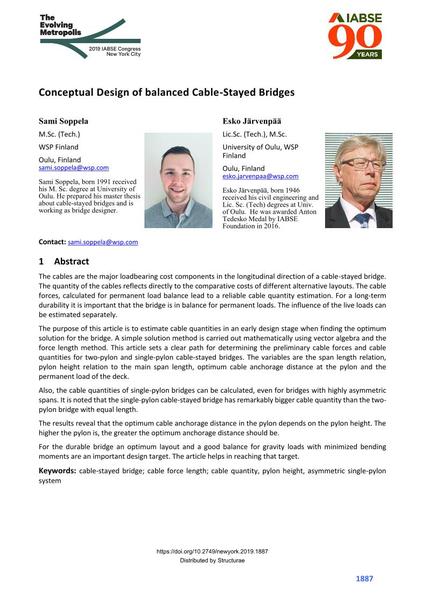Conceptual Design of balanced Cable-Stayed Bridges

|
|
|||||||||||
Bibliographic Details
| Author(s): |
Sami Soppela
(WSP Finland)
Esko Järvenpää (University of Oulu; WSP Finland) |
||||
|---|---|---|---|---|---|
| Medium: | conference paper | ||||
| Language(s): | English | ||||
| Conference: | IABSE Congress: The Evolving Metropolis, New York, NY, USA, 4-6 September 2019 | ||||
| Published in: | The Evolving Metropolis | ||||
|
|||||
| Page(s): | 1887-1891 | ||||
| Total no. of pages: | 5 | ||||
| DOI: | 10.2749/newyork.2019.1887 | ||||
| Abstract: |
The cables are the major loadbearing cost components in the longitudinal direction of a cable-stayed bridge. The quantity of the cables reflects directly to the comparative costs of different alternative layouts. The cable forces, calculated for permanent load balance lead to a reliable cable quantity estimation. For a long-term durability it is important that the bridge is in balance for permanent loads. The influence of the live loads can be estimated separately. The purpose of this article is to estimate cable quantities in an early design stage when finding the optimum solution for the bridge. A simple solution method is carried out mathematically using vector algebra and the force length method. This article sets a clear path for determining the preliminary cable forces and cable quantities for two-pylon and single-pylon cable-stayed bridges. The variables are the span length relation, pylon height relation to the main span length, optimum cable anchorage distance at the pylon and the permanent load of the deck. Also, the cable quantities of single-pylon bridges can be calculated, even for bridges with highly asymmetric spans. It is noted that the single-pylon cable-stayed bridge has remarkably bigger cable quantity than the two- pylon bridge with equal length. The results reveal that the optimum cable anchorage distance in the pylon depends on the pylon height. The higher the pylon is, the greater the optimum anchorage distance should be. For the durable bridge an optimum layout and a good balance for gravity loads with minimized bending moments are an important design target. The article helps in reaching that target. |
||||
| Keywords: |
cable-stayed bridge cable force length cable quantity pylon height asymmetric single-pylon system
|
||||
